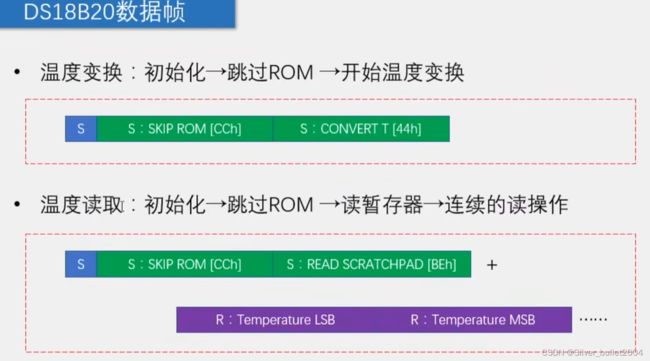51单片机学习--DS18B20温度读取&温度报警器

需要先编写OneWire模块,再在DS18B20模块中调用OneWire模块的函数

先根据原理图做好端口的声明:
sbit OneWire_DQ = P3^7;
unsigned char OneWire_Init(void)
{
unsigned char i;
unsigned char AckBit;
OneWire_DQ = 1;
OneWire_DQ = 0; //总线拉低
//延时500us
i = 227; while (--i);
OneWire_DQ = 1; //释放总线
//延时70us
i = 29; while (--i);
AckBit = OneWire_DQ;
//延时500us
i = 227; while (--i);
return AckBit;
}
void OneWire_SendBit(unsigned char Bit)
{
unsigned char i;
OneWire_DQ = 0; //总线拉低
//延时10us后直接读电平
i = 4; while(--i);
OneWire_DQ = Bit;
//延时50us凑满时间片
i = 22; while(--i);
OneWire_DQ = 1;
}
unsigned char OneWire_ReceiveBit(void)
{
unsigned char i;
unsigned char Bit;
OneWire_DQ = 0;
//延时5us
i = 2; while(--i);
OneWire_DQ = 1;
//延时5us
i = 2; while(--i);
Bit = OneWire_DQ;
//延时50us
i = 22; while(--i);
return Bit;
}
void OneWire_SendByte(unsigned char Byte)
{
unsigned char i;
for(i = 0; i < 8; i ++) {
OneWire_SendBit(Byte & (0x01<<i));
}
}
unsigned char OneWire_ReceiveByte(void)
{
unsigned char i;
unsigned char Byte = 0x00;
for(i = 0; i < 8; i ++) {
if(OneWire_ReceiveBit()) {Byte |= (0x01<<i);}
}
return Byte;
}
至此,OneWire模块就写好了,接下来在DS18B20模块中模拟数据帧:

#include 之后只需要在main中调用即可
#include 接下来进行一些综合的应用:温度报警器,按键可调整报警温度的上下限,且能用AT24C02记录上下限,掉电不丢失(这里默认所有温度不会超过DS18B20的芯片范围)
#include 这还没完,在与定时器的结合中,定时器的中断会影响OneWire的延时,从而影响其中的时序结构进而影响温度实时获取,所以在时序结构编写的代码中需要加上屏蔽定时器中断的代码:开始时加上EA = 0,最后加上EA = 1,改版后的OneWire模块如下:
#include 但是这样虽然能维护好单总线的通信,但这样直接屏蔽中断却会影响定时器的计时准确度,从而对定时器控制的其他模块造成影响,这也就是单总线的一大缺点,不过在这个实例中,按键的定时器准度要求并不高,所以这样控制影响不大






